Hyundai Santa Fe Limited: Enriching a well-received recipe
/Hyundai’s translation of ‘facelift’ is especially bold – really, you’re dealing with a complete refit.
Price: $89,990
Powertrain and economy: 2.0-litre turbo diesel four cylinder, 148kW/ 440Nm, 8-speed automatic, AWD, combined economy 6.1L/100km.
Vital statistics: 4785mm long, 1710mm high, 1900mm wide, 2765mm wheelbase, luggage capacity 571 litres, 20-inch alloy wheels.
We like: Improved powertrain, enhanced refinement, quality build, strong safety spec, better interior.
We don't like: Tech integration quirks (phone, speed sign recognition), challenging premium over equivalent Sorento.
FIRST, the obvious ‘funny’: Yes, Santa did come to ‘ours’ for Christmas.
More than that. He arrived four days ahead of the 25th and stuck around for three more afterward, and though there was plenty of travel involved during that period, I can attest every kilometre clocked was in our company. Moreover, he never left out property on the night of the 24th, which all the more undermined the whole Claus and Co ‘people to see, places to go and just a few hours to do it in one global hit’ mission statement.
Okay, so that about as far as the ‘punny’ side can be stretched; you’ll should have surely already fathomed by now, hopefully with some ho-ho-ho, that the Santa in question wasn’t a bearded stout bloke but the updated version of Hyundai’s now second-largest (having been bumped by Palisade) sports utility.
Having the new Santa Fe Limited for test during the Christmas break was a treat. Hyundai New Zealand’s car even provisioned in a seasonally-appropriate hue; what they call it ‘lava orange’ is really quite red-tinged. Even if you think otherwise, you’d agree it is the best hue you could have for this car. It accentuates all the design highlights and makes it look properly premium.
Again, that’s fitting, given the circumstances. Santa Fe stickers have progressively, and often significantly, stepped up with every model change for some time now. The latest continues that trend; the Limited now in optimal 2.2-litre turbodiesel format leaves just $10 change from a $90,000 outlay.
Is that rare air for a high flier? Here’s the thing: Every new generation has become an even bigger success than the last. On top of this, the most expensive version are consistently the biggest sellers.
Hyundai NZ will say this shows that, as gambles go, the strategy has so far been pretty much a safe bet. But I’d offer two counter-points. First, from everything I can see, NZ seems to have become one of the more expensive places to buy the car in right hand drive.
Also, look at where Kia slots the new Sorento. Their Premium variant that is a doppelganger in all but styling to the Limited is a full $13,000 cheaper. How the subordinate and parent brand can site so far apart is for each to explain; what it means is that the biggest threat to the car on test comes from another family member.
Back to the Santa Fe. What we get is a mid-life facelift of the car that has been in production since 2017. What we see is something much more. So much has changed that impression of it being a new thing, though technically wrong, can hardly be called misguided.
The exterior stylists have been busy – a different nose and tail are the most obvious changes - the cabin’s been extensively made over, there’s a lift in driver assistance tech, it switches to another platform from within the wider family and gains a next generation engine, now matched to an eight-speed twin-clutch automatic, continuing with all-wheel drive.
The front-end refurbishment is take-or-leave at Limited level; Hyundai configures the car with two grille designs this time, with the premium edition taking the larger, more chromed version. I understand that big grilles are a thing now, but this one is … erm, overwhelming in its glam-ness. The new Tucson that will soon show here has something similar, but also achieves a really cool back-lighting effect that changes the whole thing. Perhaps it’ll become a running change for the big brother. In respect to lighting, the Santa Fe places running lamps up high and the main headlights down low; again, it’s a bit out of the norm, but there’s no qualms about their effectiveness.
From the inside looking out, much better. The step up in interior quality and ambience grab you immediately; soft quilted leather, double-glazed front door glass, a very decent stereo and a whole new, LCD-predominant instrumental layout all firm up the luxury image. Sure, there are a few harder-wearing plastics to be found, but overall it feels high tech and prestigious.
The emphasis on enhanced minimalism has resulted in one of the core controls being divested. Losing the traditional gear shifter comes with the adoption of fully electronic operability; having buttons for drive, reverse, park and neutral is not ground-breaking even within Hyundai ranks (the Kona EV has gone this way) and you cannot fault argument that the tranny is so smart it hardly requires hand-motivated involvement (which can still be enabled by steering column-mounted paddle shifts). Still, the button layout looks a bit chintzy and it’s a layout that will require some practicing with before it becomes instinctual.
Below this, something else new. A Terrain Mode selector. Santa Fe achieving a control knob to switch between modes for sand, snow and mud, as well as eco, sport, comfort and smart modes, the last of which automatically recognises the driving style and selects a mode so the driver does not have to, is intriguing.
Does it make this car a Land Rover hunter? Well, no. It’s hard to imagine the Santa Fe being taken on expeditions into truly tough terrain; ground clearance is modest, there’s no robust underbody protection and it drives on road tyres. That makes it more crossover than cross country in my book, but maybe Hyundai knows otherwise.
The centre touch screen and the wholly LCD display directly ahead of the driver are also start again and are well sorted, packed with smarts and really lift the interior presentation.
Santa Fe has all the usual driver assists and accident avoidance systems, and was also one of the first SUVs with child-minded features such as a reminder about seat occupancy and doors being opened. That sense of responsibility carries into the new car with a camera set-up that checks out blind spots, activating when you’re indicating into a turn. The speedo or tacho dials transform into camera views down the relevant inside flank. It’s a good safeguard and a reminder, perhaps, that cheeky cyclists are a worldwide problem. Another assist is a self-park feature that allows you to stand beside the car and, from pushing a button on the key fob, activating it into a self-drive mode, moving either directly forward or reverse at low speed. It’s really just for tight parking spots, obviously, and is carefully calibrated (it won’t work unless the car is locked and cabin vacated), with self-stopping to avoid striking solid objects.
Some of the technology implementation is a bit haphazard. The car’s speed sign recognition and phone integration set-ups are deserving more attention, in both instances because there’s been failure to embrace latest practices. Simply to save dollars?
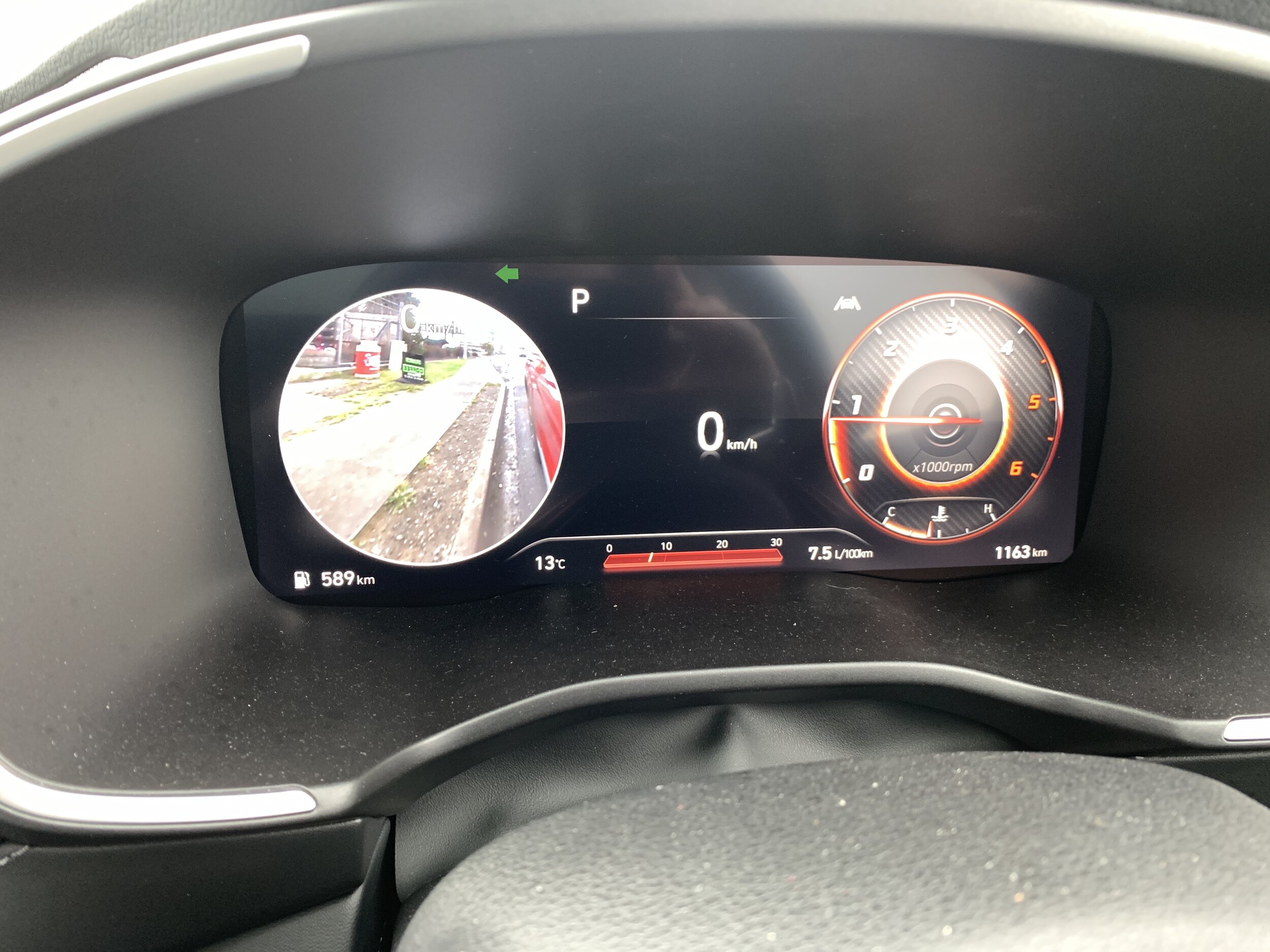
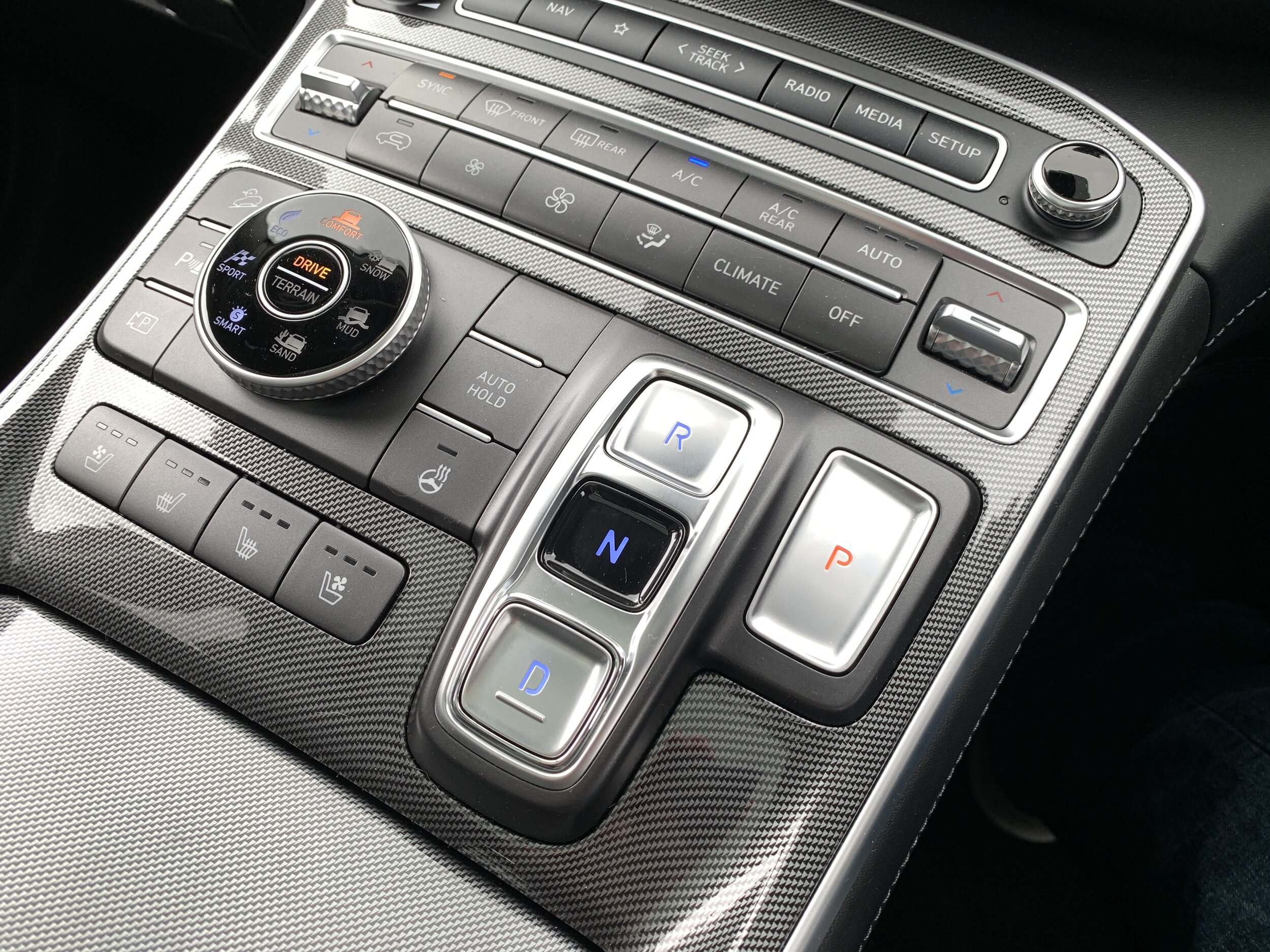
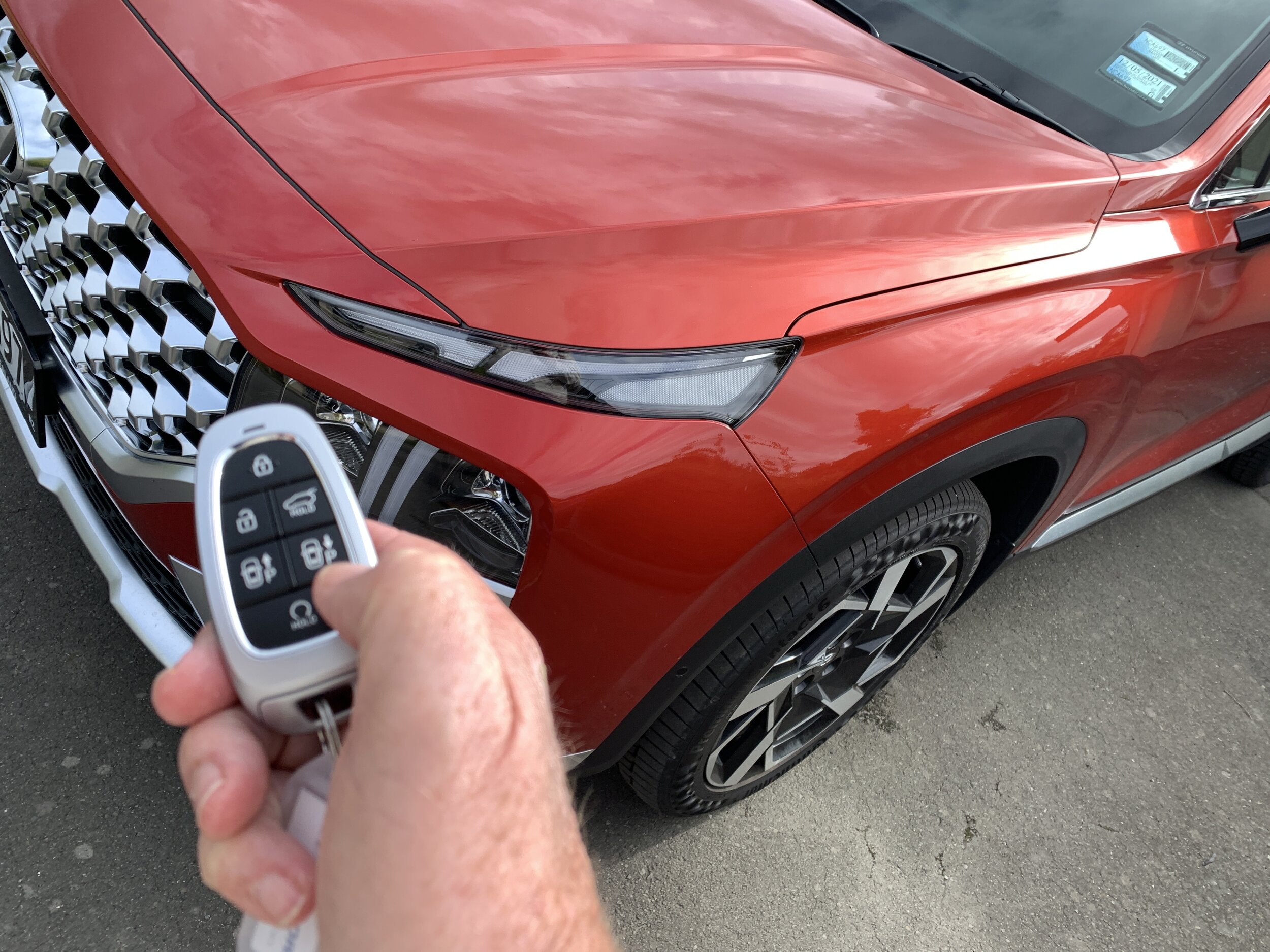
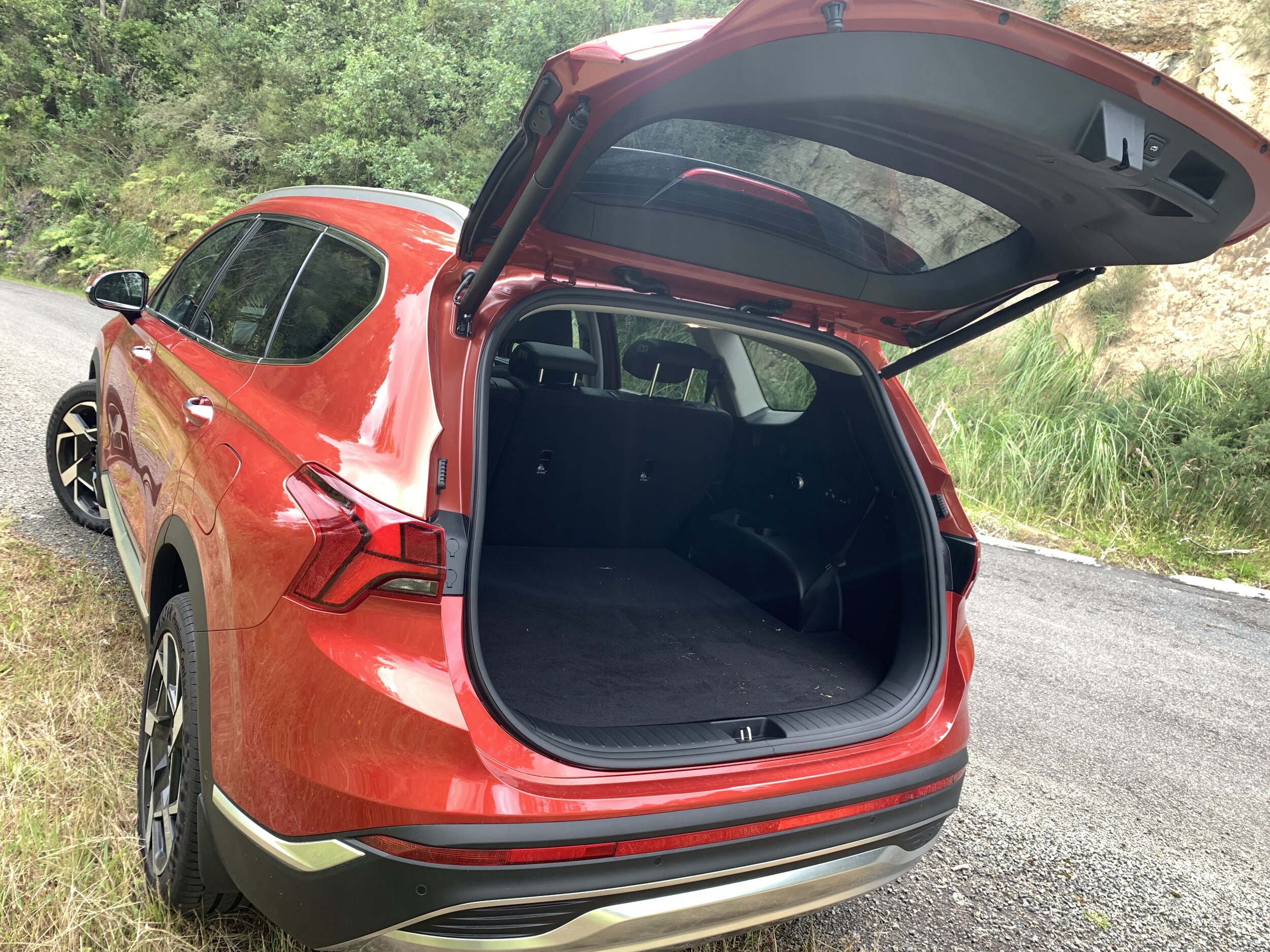
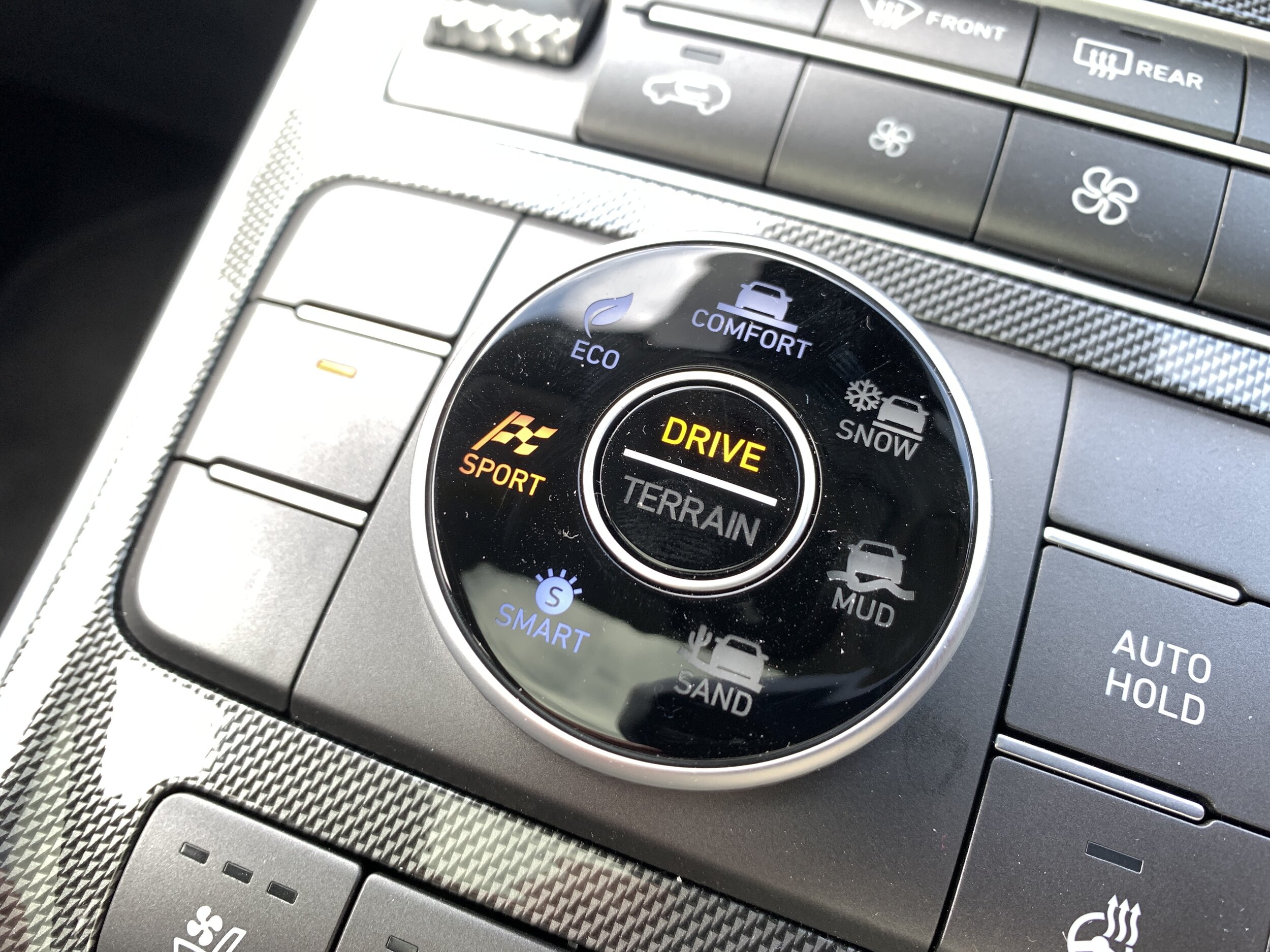
With the first function, Hyundai would be better off with what others tend to now use; a camera-dedicated system with smarts to recognise and relays signs in real time. However, instead Santa Fe relies on navigation data from the onboard sat nav. The drawback there is that this can often be outdated, because mapping doesn’t tend to be updated regularly. So it transpired on this test.
Three months ago a 50kmh sector was implemented within a section of 100kmh road near me. That obviously hasn’t made the mapping update; the system was oblivious to it. I’m sure that wouldn’t wash as an excuse. On the other hand, the Santa Fe did insist on warning about a fixed speed camera … removed ages ago.
The Apple CarPlay/Android Auto integration is also irksome. The wireless charging that now includes really asks for wireless tethering to meet best practice now. Here, though, you get a Qi recharging pad yet, to enable your phone as an audio source, there’s requirement for cable tethering. Which is self-defeating. If I cable in, there’s no need for a charger; the phone will simply pull in power from the USB; yet conversely, the charger is the most logical place to leave the phone. Also, the charge mat and US inputs are poorly-sited, by being on each side of the front cupholders, which raises potential of fouling any drinks with the cable. If the holders are empty, you can hide the whole area under a cover; except that, occasionally, the cable would get caught in the mechanism. A Bluetooth audio connect would resolve everything. So, if the facelift gets a facelift, let’s hope that’s a priority.
The car’s overall strength continues to be spaciousness. In that respect, the usual attributes from the previous Santa Fe - plenty of oddment storage in the doors and consoles – are enlivened by improvements Hyundai has facilitated by eked out some extra human occupancy room, especially for the second row of seats, which is claimed to have 39mm more leg room.
With all seats in place boot capacity remains unchanged at 130 litres, but drop the rearmost, child-prioritised pews and 571-782 litres (up from 547) is available depending on the position of the middle seats (they’re on sliding rails). With all rear seats stowed 1649 litres of commodious cargo capacity is afforded.
The driving side of things is also a story of progression. The ‘newness’ of the N3 platform it has moved to is valid only in respect to the Santa Fe itself.
Hyundai and subordinate Kia have a strange habit of building outwardly sister cars on slightly different underpinnings; in this instance the one that the Sorento has had for several years (and maintains) is also adopted by Hyundai.
Change to driving mannerism is beneficial; Santa Fe continues to trade on its core appeal of a resolved ride quality, but perception that dynamic confidence – the area where the Sorento has perhaps eked ahead – also comes transmits with equal clarity. It’s not outright sporty, but neither is the Kia; to go that way would be self-defeating, given the primary audience.
All the same, it deports with a surety that will not disappoint and strikes as being a car in which long journeys will be achieved in comfort and without the driver feeling as though they’ve had to work all the way. All the key controls perform well and in line with a sorted seven-seat SUV. The driving position is solid – a little more side support from the seat wouldn’t go amiss – the steering feels well weighted, the brakes feel reassuring, and there’s good visibility all around thanks largely to the decent glass area and wide-view side mirrors.
Santa Fe’s refinement has always been decent, but seems all the more impressive now. There’s obviously been ongoing work on quelling and road noise – Hyundai doesn’t specifically say that more sound-insulation has been added, but it would make sense if that was the case. You’d expect to achieve some tyre roar from the 20-inch rubber that the Limited runs with, but it’s very well-contained on seal, including coarse chip. What’s also apparent is the lessened mechanical tone from ahead of the firewall. The alloy engine is markedly less guttural than the old item at start-up and is smoother and less invasive on the run.
A 2.2-litre four-cylinder turbodiesel has been a mainstay for almost as long as the Santa Fe nameplate has been around and it’s interesting that Hyundai has invested in a new interpretation, this time with an alloy head and block, when it has a battery-assisted petrol, in mild and full-out plug-in hybrid, formats also coming into line. Conceivably, the latter will ultimately become the priority for meeting environmental mandates.
The diesel is lighter by 19kg and said to be more efficient. Whether it will remain the thriftiest engine remains conjecture until Hyundai releases the hybrids’ claimed economy, but it looks good for the type. Claim of it delivering an optimal 19 percent greater efficiency and 6.1 litres per 100km economy wasn’t supported on the test week; but the driving cycle was hardly conducive. Still, it hardly gulped.
Like its predecessor, the diesel delivers its best attributes through the low to medium rev range; there’s a load of easy-going pull from the get-go. Some high-end Euro diesels are smoother still, but Hyundai has nothing to be ashamed of. The unit’s muscularity will doubtless hold it in good stead when accessing the 2500kg braked towing capacity.
A variation of the one to be fitted to the i30 N hot hatch, the new eight-speed box undoubtedly also enhances the engine’s capability. It uses oil-submerged clutch packs, so it’s deemed a ‘wet’ gearbox, which aids cooling and NVH levels. It’s a slick unit, with swifter responsiveness than the old auto. The real test for DCTs is how they perform in low-speed, stop start driving – basically your end-of-work day urban crawl. Good to say that, when subjected to this, it rarely seemed to fall into the jerkiness that blights some DCTs. It’ll rev-match on down changes, while there’s a Sport mode should the mood take you.
A slicker, smarter, more refined and far from-anonymous Santa Fe relates how confident Hyundai has become as a car maker. Brand assertion about the car having assumed a ‘a new level of luxury’ is fair; the flagship definitely has a premium look and feel. The manner in which it drives and performs also speaks volumes. It’s a class act; good enough to mix more comfortably with Euro elites in this sector.
But you might well say the same about a certain close relation. Talk about the art of the deal.




















